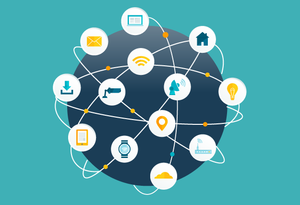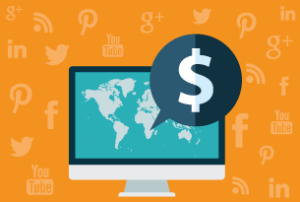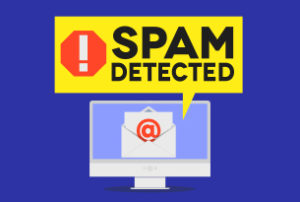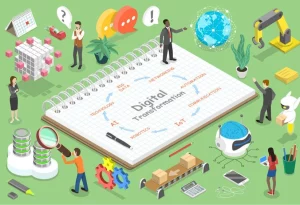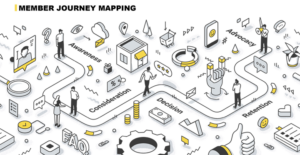In the field of Marketing, every few years there is a term that gains a lot of popularity. A few years ago everyone was talking about Social Media. And now, everyone is talking about Digital Transformation. Here are a few definitions of Digital Transformation that we often hear from our clients or our client say they hear from different vendors:
“Digital transformation is building a new website or a mobile application.”
“Digital transformation is stop spending your marketing dollars on traditional media like direct mail, radio ads, television and start spending it on the online channels like Google or Bing pay-per click (PPC), Facebook, Twitter, LinkedIn etc.”
“Digital Transformation is implementing a new Association Management System (AMS) or a Client Relationship Management system (CRM) e.g. iMIS, Wild Apricot, Personify, Salesforce.com, SugarCRM, Microsoft Dynamic etc. So buy our product.”
“Digital Transformation is replacing traditional email list based software like Constant Contact or MailChimp with a sophisticated Marketing Automation system (Eloqua, Marketo, Pardot, Active Campign etc).”
“Digital transformation is purchasing Google Home, Alexa, Amazon echo for your office!”
All of the above definitions view Digital Transformation either, in a very narrow spectrum or, get it completely wrong and therefore are misleading. It is almost as if the term “Digital Transformation” is being “abused” and taken advantage of.
Over the last decade, so much has changed in the world of Marketing and Technology. The old thinking has been all about pushing the programs, products or services to your client base. The new thinking puts your client at the centre and therefore, is about meeting the needs of the client (or member). Some key changes that have taken place that are shaping the future are:
- Movement to cloud computing and maturation of Infrastructure as a Service (IaaS), Platform as a Service (PaaS), and Software as a Service (SaaS). E.g. platforms like Amazon AWS, Microsoft Azure, Office 365, WP Engine etc.
- Smart phones has become the device that powers the world whether it is B2B or B2C.
- Changes in the compliance and regulations e.g. Accessibility for Ontarians with Disability Act (AODA), Canadian Anti-Spam Law (CASL), most recently, General Data Protection Regulation (GDPR) that requires businesses to be more transparent about how they market to their stakeholders.
- Ongoing explosion of Social media sites and their use (read “abuse”) by Marketers. As well as, changes in how we socialize with each other.
- Email losing its relevance in the world of list-based email marketing systems. Open rates reduced from 80% to about 30% and click through rates reduced to about 2-3%. Emergence of sophisticated marketing automation platforms to save the email marketing by helping organizations become more relevant and targeted in their communication. (it is fascinating to see still a vast majority of businesses use list-based systems like Constant Contact, MailChimp, Clickbacks, etc.
- The framework based solutions like Client Relationship Management (CRM) becoming more affordable and no longer a magic bullet only available to an “enterprise” business.
- Changes in the way human beings learn and educate themselves. Movement from structured classroom learning to an on-demand learning environment. Imagine platforms like linda.com, udemy, khan academy etc.
- Availability of “free” information through Google.
- An exponential increase in the number of cybersecurity related incidents and data breaches. Clients still do not understand how vulnerable they are.
- Maturity of online advertising with Social Media platforms like Facebook, Twitter, LinkedIn, and YouTube building more robust advertising platforms. Reduced relevance of ongoing huge spends to cheat Google to gain a higher Search Engine (SEO) ranking.
- Replacement of routine and non-value adding chores through Artificial Intelligence platforms and established connectivity between the devices through the Internet of Things (IoT).
- Emerge of Blockchain technology as the panacea of establishing trust in today’s digital world.
We believe, most importantly, there has been a shift in the client/member expectations. Businesses need to constantly adapt and change to meet or exceed these expectations. While managing this change is a big challenge for organizations, this is also a big opportunity. As an old saying goes “If you are not part of the road roller, you are part of the road”. Digital Transformation is about ensuring you are part of the road roller.
Based on our years of experience helping organizations adopt Digital technologies, we define Digital Transformation as retooling the organization with systems and processes (web, social, billing, programming, member management, advocacy etc.) to be truly customer-centric (or member-centric). It is about differentiating and empowering the organization to improve service levels, member retention, and outreach using the digital channel.
True Digital Transformation is a mix of strategy, technology and design skills that requires immaculate planning and a process to transform. At 108 ideaspace, we have used our 5 R’s process to transformation to help a number of organizations successfully transform and thrive in the changing digital landscape. Contact us today to learn more about our Digital Transformation process and how we can help.

